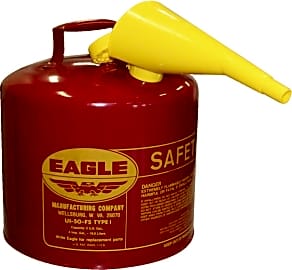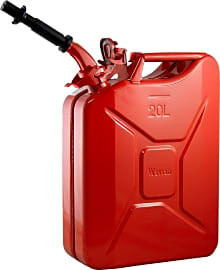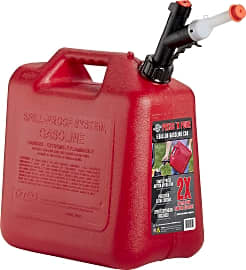The 10 Best Gas Cans

This wiki has been updated 40 times since it was first published in February of 2016. We've all done it, so it's OK to admit that you ran out of gas and got stranded. While we don't recommend driving around with a full gas can in your car, they are smart to keep on hand empty so you have a safe way to bring fuel back to your vehicle after getting a ride to a gas station. They're also perfect as containers for filling up lawnmowers and other garden equipment. When users buy our independently chosen editorial recommendations, we may earn commissions to help fund the Wiki.
Editor's Notes
February 05, 2021:
During this update, we didn't need to replace any of our existing recommendations, as they are all still proving to be as reliable and functional as anything else on the market. We did, however, identify two new options to add. The first is the Husqvarna Combi, which stands out from the rest thanks to its two-tank design, offering a place to store both fuel and oil, and keep them separate. The second is the Garage Boss GB351, which, while it has its drawbacks, is a basic, budget-friendly option that gets the job done, even if it doesn't have any revolutionary features worth spending much time talking about.
May 03, 2019:
Because they are durable and relatively easy to use, we still find the No-Spill 1405 Poly, the Eagle Type I Red, and the SureCan 5 Gallon to be top selections. You won't have any worries if you choose to use them for transporting fuel to your various gas-powered implements, such as lawn mowers, and if you must leave gas in them for a while, they shouldn't leak when closed and stored properly. They are all CARB-compliant, and the Eagle Type I meets OSHA standards, to boot. The Justrite AccuFlow Type II is another option to consider, but its extra-large nozzle can be either a blessing or a curse, as it does not fit into the filler necks found on many modern cars. It's about as rugged as they come, though, with lead-free construction that's backed by a 10-year warranty. After some consideration, we kept the offering from Midwest; the biggest complaint against it is the EPA-complaint nozzle, which is cumbersome, but the actual container is durable enough for casual use. And, finally, we removed the VP Racing 3522 Utility Jug, which leaks from the bottom seam too often for comfort.
Packing In The Petrol: Get The Right Gas Can
These options are often heavy and rather cumbersome, but worth the extra bulk for long term safe storage.
It's often a wise idea to have some extra gasoline on hand, whether you want to be able to run the lawnmower without an extra trip to the gas station or you're heading into the backwoods for an extended off-roading expedition. However, carrying gasoline, whether in your garage or basement or in the trunk of your vehicle, also means an increased chance for a potentially serious accident if you don't store the volatile fuel properly.
Fortunately, there are myriad gas cans available that can help mitigate the risk of an accidental spill and/or fire. And the right gasoline can makes dispensing fuel safe, clean, and easy. You simply have to choose the right can for your needs: you don't want to try to fill that one quart sized backpack blower's tank using a huge five gallon jerry can, after all.
If all you need is a reliable way to bring gas from the station to your home for filling lawn mowers, blowers, and other equipment (or for adding a gallon to a car's empty tank) then look for a one or two gallon gas can made from a lightweight but durable material such as HDPE, or high density polyethylene. This type of material resists the corrosion gasoline can cause in other substances, stands up against cracks and punctures, and also is very affordable.
For larger volumes of fuel, there are many different types of gas can available, and many of them have the same capacity: five gallons. In the five gallon category, you will find narrow, tall jerry can style gas containers (iconic of the military jeeps of the mid 20th century) that are perfect for use on long road trips or for off-roading adventures. These cans can be easily secured to a vehicle using ratchet straps or rope and are designed for the rough ride you may well give them.
Other five gallon tanks are designed for longer term storage of gas (which has its limits — see below for more information on that) and are made with extra thick, durable materials like stainless steel. These options are often heavy and rather cumbersome, but worth the extra bulk for long term safe storage.
Finally, there are gas cans available that create a veritable filling station right there at your own home or business. These extra large gas cans can be operated with a pump handle that creates a steady flow of fuel, quickly filling the tank of your vehicle or machinery and even able to create a siphon to reverse the flow and drain fuel if needed.
Safe And Proper Gas Can Use
Before you ever fill a gas can, first make sure you are about to use the right fuel. That means using fuel that is approved for safe storage in the type of gas can you own, and that the can has not previously been used for a different type of fuel.
Once a gas can has been used for one type of fuel, it should be used for only that one type of fuel going forward.
Mixing diesel fuel with regular unleaded gasoline can lead to severe engine damage, for example. So too can using can in which fuel and oil have been blended for use in a device like a gas powered chainsaw lead to irreparable damage and even danger. Once a gas can has been used for one type of fuel, it should be used for only that one type of fuel going forward.
Once you know you are using the right container for the right gas, set the gas can on the ground and step away momentarily, finding something metallic that you can touch do release any static electricity that may be built up in your body. Then place the nozzle of the fuel pump into the gas container and commence filling the can. Never overfill a gas can -- it is better to in fact purposely undersell the can slightly to ensure it does not overflow, spilling fuel.
A filled gas can should be carefully sealed and, if possible, left outside and undisturbed for a time so any accidental drips of fuel can vaporize and disperse.
A Few Words About Fuel
Gasoline is the end product resulting from extensive distillation and refining of petroleum and the subsequent blending with multiple other components. In fact, the fuel you use in a a vehicle or machine contains no fewer than 500 hydrocarbons, or compounds made up of a balance of hydrogen and carbon atoms.
Thus old gas, even that which has been ostensible stored correctly, is a liability for engines and a safety hazard -- or in other words, it must be disposed of.
Gasoline is frequently known simply as "gas" for a reason: it rapidly vaporizes if not properly housed, so a purpose built container that fully seals is a must for gas storage. But even the best gas can in the world cannot store gas definitely. Gasoline, being inherently volatile and being made from various blended components, will remain stable and fully safe for all uses for only around six months to a year under most circumstances.
Beyond that point, the separation of the various components begins to render gas less and less effective as a fuel source for internal combustion engines, but it is still highly combustible and flammable. Thus old gas, even that which has been ostensible stored correctly, is a liability for engines and a safety hazard -- or in other words, it must be disposed of.
Proper gasoline disposal is a must both for safety and environmental concerns. The only responsible way to get rid of old gas is to turn it over to a certified hazardous waste disposal facility, or else to bring the gas to a fuel filling station that accepts old fuel and oil. Many gas stations have programs to safely reclaim old fuels and motor oil, and in fact are obligated to do so in many states. Just know that turning in old fuel may necessitate surrendering your gas can; it's a small price to pay for doing the safe and environmentally friendly thing.















